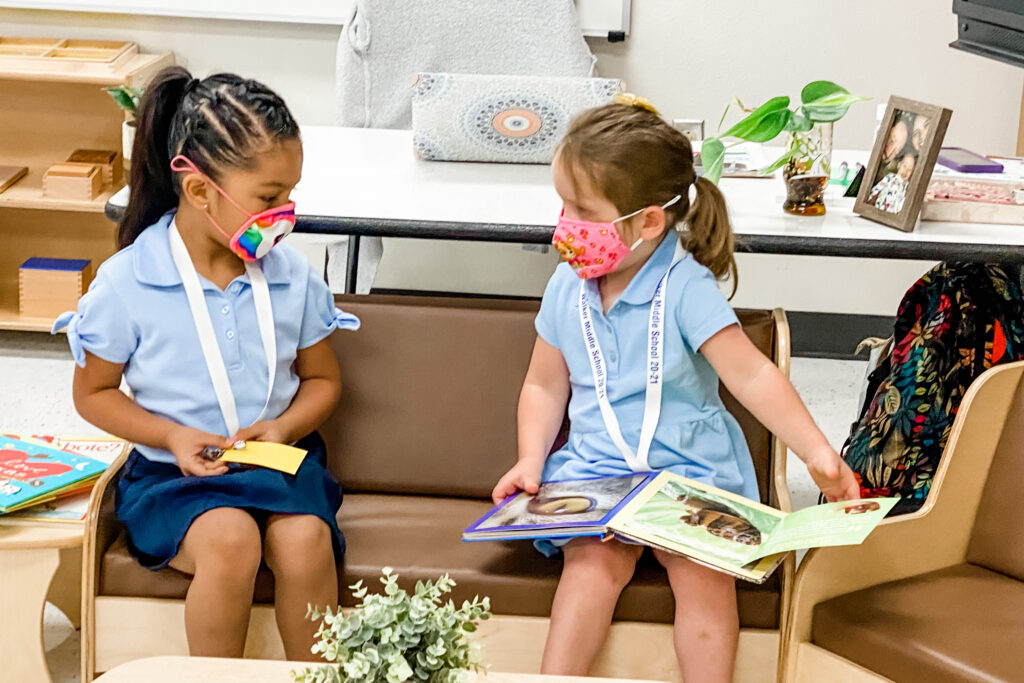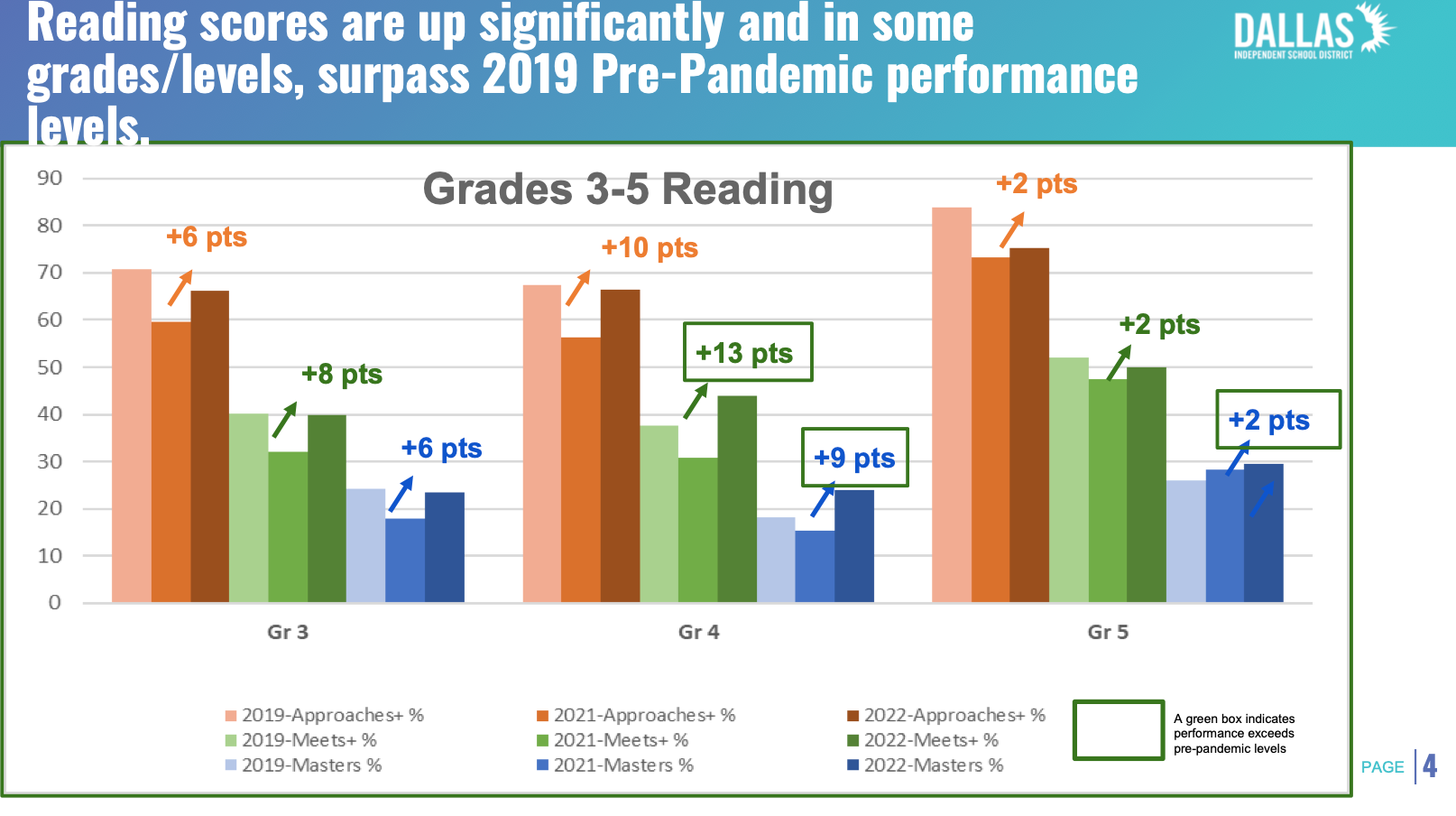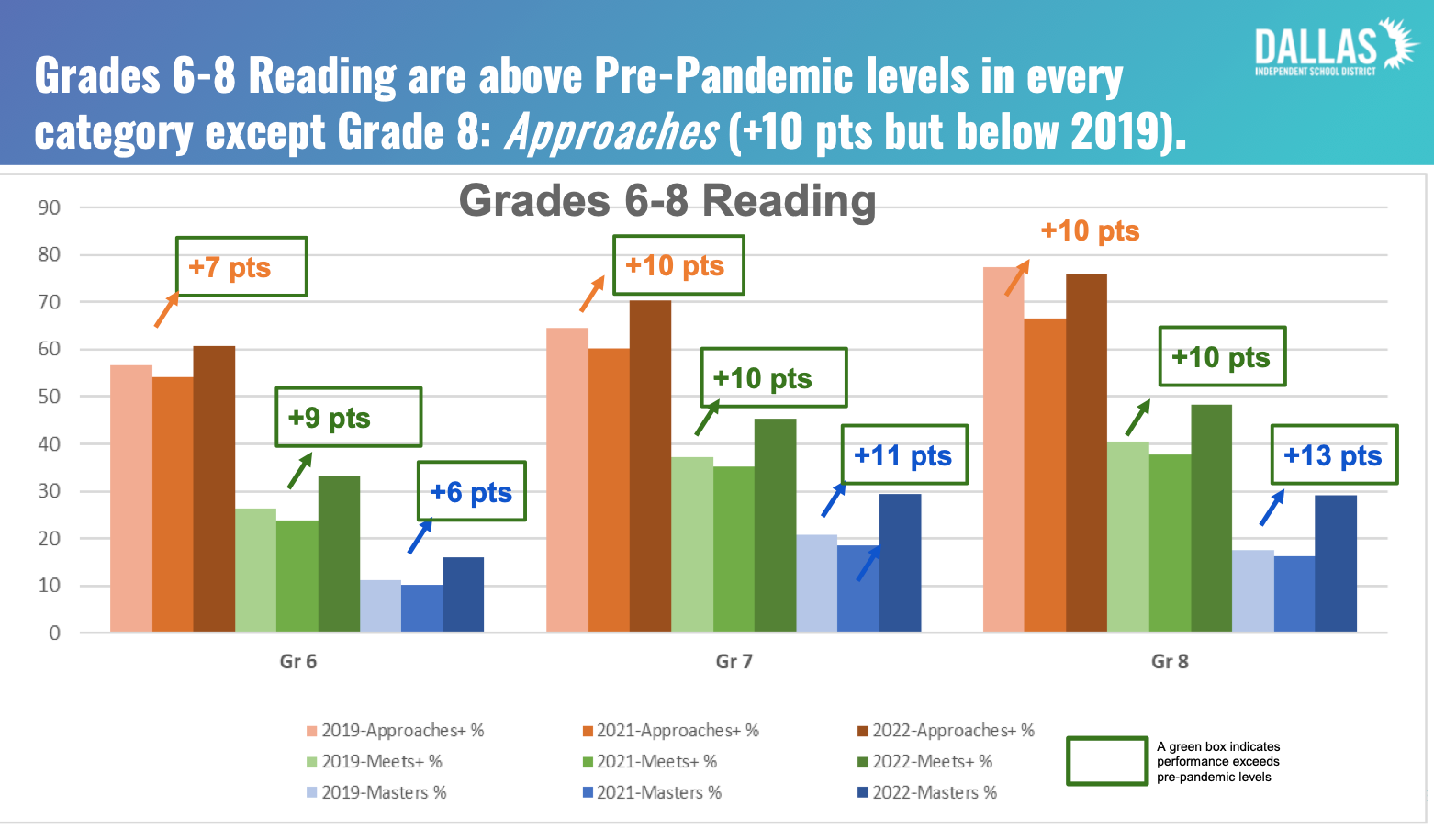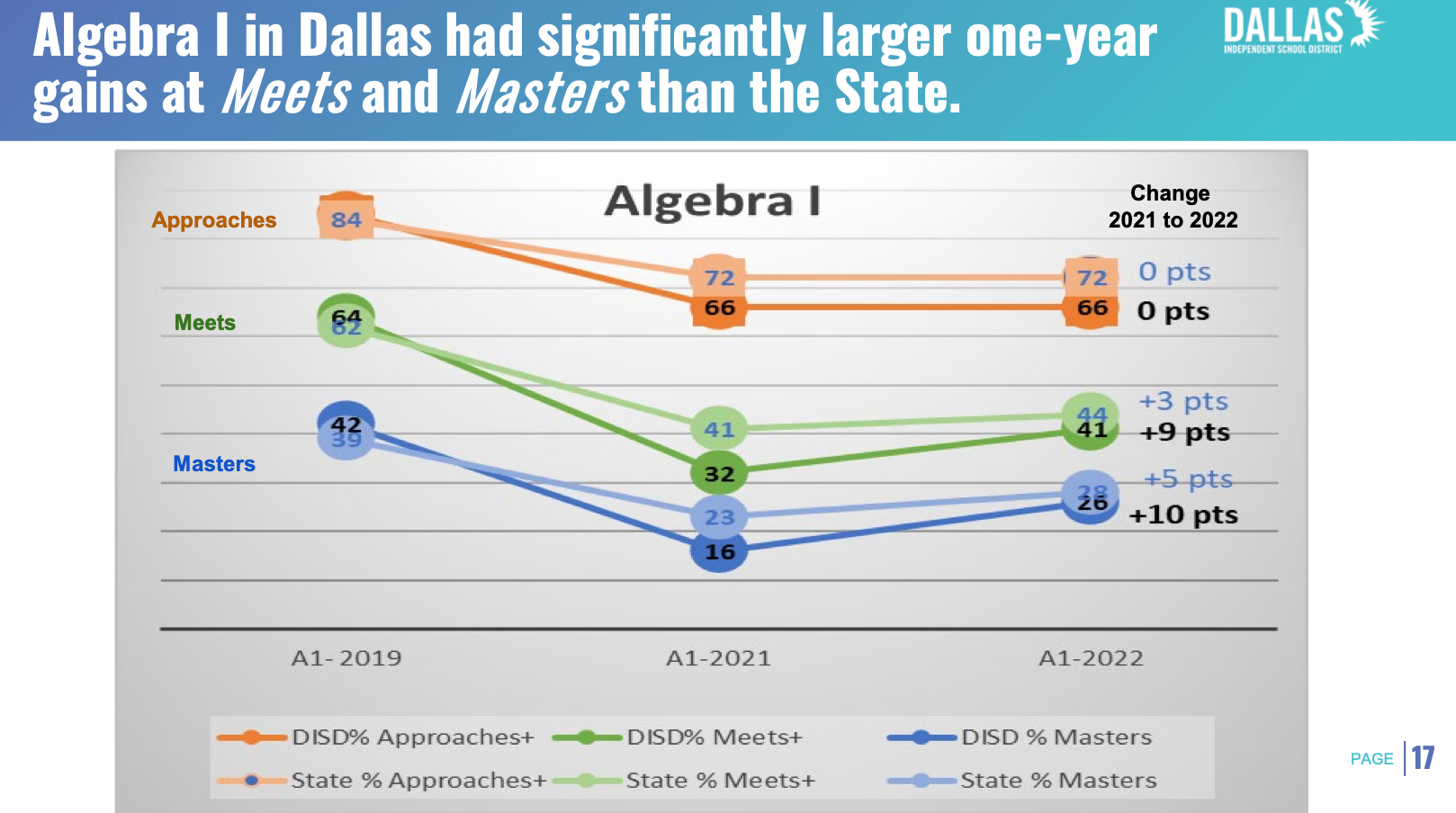After the pandemic showed horrific learning loss among students, this year’s preliminary State of Texas Assessments of Academic Readiness (STAAR) results have Dallas ISD officials surprised and optimistic. Really optimistic.
In last week’s school board briefing, Deputy Superintendent Susana Cordova revealed an early glimpse of this year’s STAAR and high school end-of-course exam results. They showed a surprising turnaround for a district that posted reading and math declines across all tested grades in elementary and middle school last year.
In fact, in some grades and subjects this year, the district’s gains have surpassed pre-pandemic results from 2019. (The STAAR was canceled in 2019-2020 because of the pandemic.)
This is the earliest that the district has ever had results, largely because nearly all students took the test online. District staff told the board that an informal survey of other urban districts in the state revealed that they may have had the highest percentage of students taking the STAAR test online this year, with many districts still doing a mix of paper and online testing.
Cordova stressed that while these results were encouraging, there was a lot of data they didn’t have yet. She’s looking for things like state benchmark levels and the results of other urban districts.
“Despite falling significantly during the pandemic between 2019 and 2021, we have seen this year significant gains in reading,” Cordova said, calling the increases a “dramatic rebound,” with gains as high as 18 percentage points for Black students.
In 2020-21, students in third through eighth grades who failed the reading portion of the STAAR exam rose by as much as 11 points in the fourth grade, with a higher-than-usual number of students in the other grades also not meeting state standards.
This year, every grade level showed gains in meeting and mastering the state standard, as well as in students that were close to, or approaching, that standard. Fourth graders had greater gains in meeting and mastering than pre-pandemic levels, and fifth graders had higher than pre-pandemic level gains in meeting the state standard as well.
For middle schoolers, nearly every single grade level posted higher than pre-pandemic gains in approaching, meeting, and mastering reading, with the exception of eighth grade, which posted gains in approaching state standard that weren’t quite as high as 2019.
“We’ve made significant gains, most in the double digits, and most above pre-pandemic levels,” Cordova said.
For bilingual students and non-English speakers, the gains in reading look promising, but there were declines in fifth grade.
Math scores also showed some significant promise, but the gains weren’t quite enough to bring the district to pre-pandemic scores. But, for context, 40 percent of all seventh graders failed the math portion of the test last year. This year, the district’s preliminary figures show more growth (as much as 5 points among students approaching state standards).
“Our math gains ranged from three points to 12 points for all students,” Cordova said. “But we have not yet hit our pre-pandemic performance.”
Most experts predicted (and the research agreed) that the math slide would be more severe than the reading slide; math concepts were proving more difficult to teach virtually. A look at unfinished learning by McKinsey & Company found that the learning gap for math put students (on average) about five months behind.
End-of-course STAAR exams given to high school seniors also showed promise after significant drops last year. While scores aren’t at pre-pandemic levels yet, Cordova said that Dallas ISD students made greater gains than the state in Algebra 1, Biology, and U.S. History, sometimes more than double the state average.
English I showed a decline, but it wasn’t as severe as the rest of the state.
“We lost less ground than the state did,” Cordova said, adding that the state and Dallas are seeing drops in approaches and meets in English I.
Dallas ISD trustees were enthusiastic and curious about the results.
“These are pretty amazing and shocking results, in a good way,” said Trustee Dustin Marshall. “I would have wagered heavily that you guys weren’t going to see these large gains, especially the ones that are above the prepandemic performance.”
“If you remember back a year ago, we were all hearing things about a ‘lost generation’ and how learning would never be recovered, that we’d be off track for a generation,” Trustee Dan Micciche said. “I really feel a whole lot better now, having seen these surprisingly good results.”
But every single trustee had the same question: how?
Cordova said the district is now wading through data as it comes available and double checking to make sure there weren’t any testing irregularities. “We did test more students, and that may also contribute to what we see,” Cordova said. Roughly 85 percent of students took the STAAR last year, compared to almost 100 percent this year.
The biggest change, she said, was that all students were on campus this year. Last year, students could attend remotely or in person, and mileage varied significantly on the success of virtual attendance.
The district also retained 600 teachers over the district’s usual funding formula thanks to a federal grant program called ESSER, Elementary and Secondary School Emergency Relief.
“We also had a very explicit focus on African American students, particularly in schools that have a high concentration of African American students,” Cordova said. “It’s likely that all of those things paid off to some degree.”
“Our teachers were warriors that did a tremendous job under tough conditions,” Superintendent Michael Hinojosa said. “I also saw a lot of collaboration everywhere, especially between (the district’s) teaching and learning and school leadership. We did a lot of different things, and it’s way too early to know which works the best.”
Pam Lear, the district’s Chief of Staff and Racial Equity, said the district’s gains were likely buoyed by a strategy that allocated resources to students strategically.
“Whenever there is intentionality and we are focusing in targeted ways, and we’re giving substantial, significant additional resources for our most fragile kids, we’re going to see gains,” she said.
One of those targeted ways, Cordova said, was taking highly-trained teaching and learning experts from Trejo’s department and placing them in schools that reported the pandemic slide the most. These experts would spend about two to three days a week at these campuses for two months, engaging with students in small group instruction.
“That was something we did intentionally to try to support the extreme needs that we saw,” she said, adding that she needed to seek permission from the U.S. Department of Education to do so. It was a new effort this year, she said, and the district could continue it next year if that kind of need persists—which it likely will.
She also attributed the improvements to the district’s approach to social and emotional learning. She highlighted its change in the way schools approach suspensions, which keeps students in a classroom more frequently.
Hinojosa said the district also made sure there was tutoring and enrichment available after school from 3 p.m. to 6 p.m., particularly in the district’s 60 high-priority campuses.
“We also had the intersession calendar at some of those schools, and had our best teachers there that week,” he said, referencing an alternate calendar that allowed some students to receive year-round learning. “We just don’t know if that was the lever, but it’s something that this board will have to study.”
Dallas ISD is also looking at this year’s teacher vacancies and student absences, and how students were performing on internal testing. It wants to suss out why students are succeeding where they’re succeeding, and why performance flattened or fell short in other areas. The district will even be monitoring English and Spanish testing to make sure that bilingual students are being tested in the appropriate language.
Cordova said she hopes to see a budget increase for reading interventionists for the next school year, specialists who are sent in to work with specific students when classroom instruction isn’t enough.
“The preliminary results from our internal data demonstrated that it was making an outsized impact on reading,” she said.
But that doesn’t mean that the district is completely content with the results this year. There are obvious gaps that will need to be addressed, and without focusing on those areas, we could conceivably see scores plateau next year.
Take those English I scores. They’re consistent with the lag district officials see in that subject across all secondary testing, including the SAT.
“We think that this is an area we need to lean into,” Cordova said, adding that improving upon those math gains to bring them up to pre-pandemic level would also be a priority.
District staff said that retaining and identifying proficient certified teachers is also a challenge that DISD is working on, too. They’re also making more decisions through an equity lens, making sure that every school has what it needs— which means some schools may need more support in one subject than another, and the focus will be on equitable outcomes, not equal spending and supports across the board.
Whatever worked, trustees said they would support spending more money on it.
“Let’s get to the bottom of what’s causing (the gains), and do it more and more and more,” Marshall said. “We don’t need to be recovering from a pandemic to want to see double digit gains in these areas. We should be doing this every year.”
And to Marshall’s point, it’s worth pointing out that some schools were already struggling pre-pandemic, which means that there will always be room for improvement in a district as large as Dallas ISD.
But the good news in all of this is what many education experts have been hoping for: a whole lot of thinking outside the box just may have produced some scalable ways to improve outcomes, pandemic or not.
You can view the entire report here.
Author











